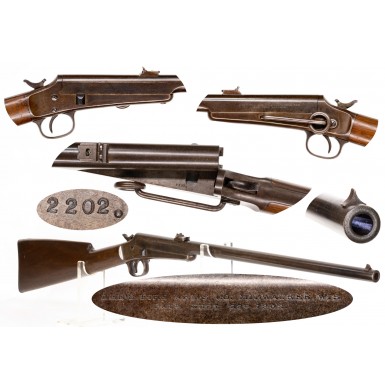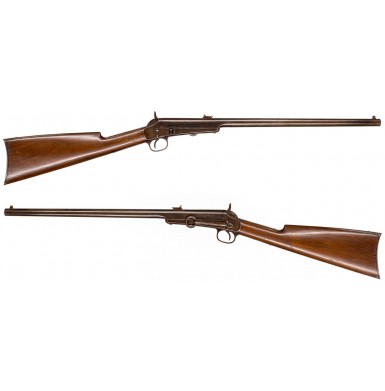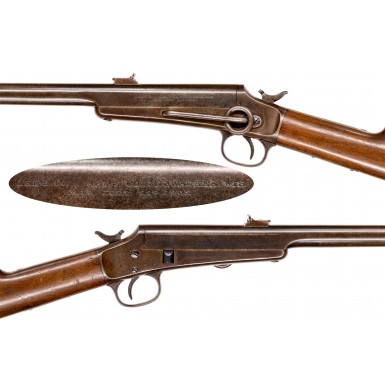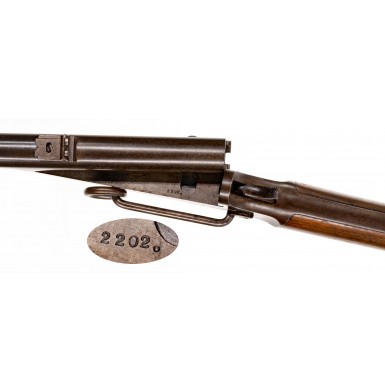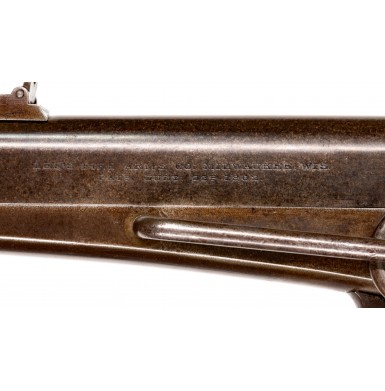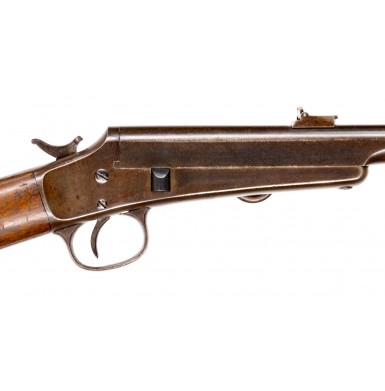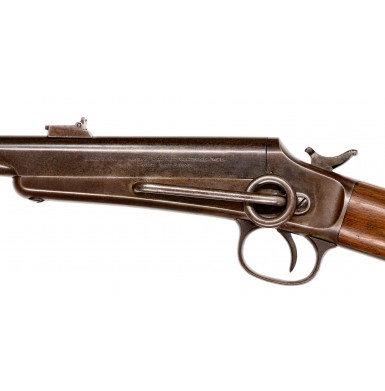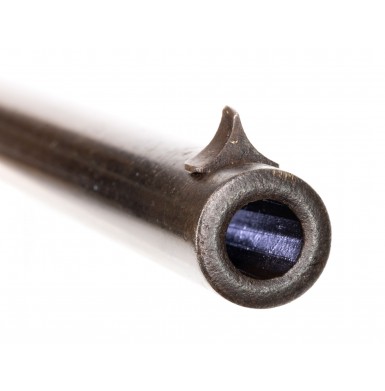Extremely Rare Lee Arms Company Saddle Ring Carbine
- Product Code: FLA-GB89
- Availability: Out Of Stock
-
$7,495.00
On 22 July 1862 James Paris Lee (1831-1904) of Stevens Point, WI received his first patent for a firearms design, #35,941. The patent was for a pivoting barrel breechloading pistol that used an interlock actuated by the hammer to unlock the breech for loading and unloading. By placing the hammer at half cock, the barrel was unlocked from the breech face and allowed to pivot to the right. If the hammer was in any other position while the action was closed, the barrel would not pivot, and the breech would not open. Over the next thirty-three years, Lee would receive no less than 17 more firearms patents and become one of the most influential firearms designers of the second half of the 19th century. To this day his name is still directly associated with the most famous of British battle rifles, the SMLE or “short magazine Lee Enfield”.
Lee was born in Hawick, Scotland in 1831 and emigrated to Galt, Ontario with his parents at the age of 5. He was apparently obsessed with firearms design from an early age and is said to have assembled his first firearm at the age of 12, although it did not function. In 1858 Lee and his wife emigrated to America, taking up residence in Stevens Point, WI. It was there that he developed his first breechloading firearm and received a patent for it. The design was intended to be a way to alter muzzleloading firearms to breechloading cartridge but was apparently not really viewed that way. Lee applied his pivoting barrel design to a military saddle ring carbine and on 18 April 1865 received a US Ordnance Department contract for 1,000 of the carbines in .44RF. Interestingly this was nine days after another Lee, General Robert E Lee, had surrendered the Army of Northern Virginia at Appomattox Courthouse. Receiving a military contract at the conclusion of a major war could be considered unlucky or at the least inauspicious, but James Paris Lee moved on the with the production of the guns. As Lee was just starting his firearms business and because the manufacturing of components like barrels required a significant amount of skill and experience, he contracted the carbine barrel production to Remington. Due to some form of miscommunication or possibly errors on the part of the Remington factory, the barrels were delivered bored to the wrong specifications. This resulted in a total rejection of the guns by the Ordnance Department inspectors. As information about Lee’s first foray into arms manufacturing are sketchy, it is not clear if the barrels were rejected by sub-inspectors prior to any guns being assembled, or if the error was not discovered until Lee made his first deliveries of the carbines. Flayderman’s notes that in late 1866 Lee had completed 255 of the carbines with another 200 in “various stages of near completion” along with several hundred in much less complete stages of manufacturing. This suggests that Lee started to complete the contract and problem was discovered upon the first deliveries and that the entire order was summarily rejected before he could complete it. It is also entirely possible that this was simply an excuse used by the Ordnance Department to get out of a contract for a non-standard carbine that was chambered for a non-standard cartridge. By late 1866 the standard carbine cartridge was the .50 caliber Spencer (.56-50 or .50 RF Government) with the standard rifle cartridge the .50-70 Government. There would have been little use in the military for a .44RF carbine. It is generally believed that Lee only completed about half of the government order and then used the balance of the parts on hand to assemble sporting arms which he sold through his Milwaukee based Lee Firearms Company. In the end the Lee Firearms Company had a somewhat inauspicious end after completing somewhere between 500 and 1,000 arms total, both military pattern and sporting. But Lee was not to be deterred and continued to design firearms.
In 1866 he received US Patent #54,744 for a breechloading firearms design and in 1871 he received yet another, #114,951. This 1871 patent would once again attract the attention of the US Ordnance Department. The design was for a Peabody-style tilting block action that was operated by a central hammer with a tall vertical spur. Striking the hammer spur with palm of the hand opened the action, causing the block to tilt down and actuated the ejector for the cartridge. Inserting a fresh cartridge closed the action automatically. Lee submitted the design in the newly adopted US Government .45-70 chambering for the 1872 US Army Rifle Trials and received a favorable response. Although his design did not beat Erskine Allin’s Trapdoor system which would be adopted as the US Model 1873, it did well enough to be considered for field trials. To that end the Ordnance Department allocated $10,000 for the production of Lee’s rifle at Springfield Arsenal. Lee relocated to Springfield to oversee production, but the majority of the money was spent on machinery and tooling to produce the rifles and in the end only 143 were manufactured before the money ran out. While one reference notes that 145 were produced, I would assume the other two guns were the original Lee manufactured trials rifles. At least 140 of the Model 1875 Lee Vertical Action Rifles were issued for field trials, but with mixed results. Although the troops liked the action and felt it was less likely to “get out of order” than the Trapdoor system, there were issues with stock breakage and with the fact that no safety or safety position for the hammer was part of the design. As such, the design and further production of the Lee Vertical Action Rifle was abandoned. But Lee was not done yet, he may have been down, but he was not out.
On 4 November 1879, Lee received US Patent #221,328 for a bolt action rifle that was fed from a detachable box magazine. From that day forward firearms design would never be the same again. Lee’s detachable box magazine was of a double column design, which allowed twice as much ammunition to be loaded than in competing designs. In a tip of the hat to the ever-conservative Ordnance Department, the design incorporated a magazine cut off that allowed the rifle to be used as a conventional single shot until the speed and firepower of the magazine was needed. The first 300 rifles were produced by Sharps for Lee and were adopted by the US Navy as the Model 1879 Rifle. Subsequent deliveries were made by Remington. Thousands of the rifles were produced as the Remington-Lee Model 1879 for the US Navy and the Remington-Lee Models of 1882 and 1885 for the US Army and finally as the Remington-Lee Model 1889 again for the US Navy. An additional military contract was received from China for 1,000 rifles. The rifles were produced for the US and export sporting markets in several calibers and configurations and the military pattern rifles were also chambered in foreign calibers like .43 Spanish and .42 Russian to encourage foreign buyers. The design piqued the interest of the British military, and was adopted initially as the “Rifle, Magazine, Lee-Metford” (RMLM) in 1889 and then as the one of the most famous battel rifles in the world, the Rifle, Short, Magazine, Lee-Enfield (SMLE), which served Great Britain for roughly a century. Lee went on to collaborate with Winchester for the Model 1895 Winchester-Lee Navy Rifle as well, but it was his bolt action magazine rifle design that would be produced in the millions as the SMLE that placed him in pantheon of firearms inventing gods.
Offered here is a VERY GOOD+ condition example of the extremely rare Lee Arms Company Saddle Ring Carbine. This was the first product of the Lee Firearms Company and was the design that had received a US Ordnance Department contract and was subsequently rejected. While records are spotty and there is little definitive information it is believed that the total production of these carbines was between 255 and no more than 500. The carbine is one of the “.44 Rimfire” guns and has a muzzle diameter of .4195” and chamber diameter of .45”. As metallic cartridge ammunition of the time was often designated by the diameter of the casing and not the bullet, these measurements seem quite correct for a .44RF cartridge that probably fired a nominally .42 caliber bullet. However, it would be easy for a government inspector to say that the bore was “out of spec” since it was not .44”. The carbine has a 21” round barrel that pivots to the right for loading and unloading when the hammer is placed in the half-cock position. The manual extractor can then be used to remove the spent cartridge case from the chamber. Pulling the hammer to full cock or lowering it to the safety position locks the action closed. The lightweight carbine is only 35 ½” in overall length with no forend and the walnut stock has a crescent iron buttplate. The original rear sight is in place, a Remington rolling block carbine style two-position L-shaped leaf sight. The short leaf is set for 100 yards, the aperture in the longer leaf is marked for 300 yards and the top “V” in the long leaf is marked for 500 yards. The original tall, dovetailed iron front sight is in place on the barrel, near the muzzle. The original 3 ¼” sling bar is present on the reverse of the frame and a sling ring is mounted on it. The only external markings are on the left side of the chamber, above the sling bar and they read:
LEE’S FIREARMS CO MILWAUKEE, WIS.
PATD JULY 22ND 1862.
The only other marking is the serial number 2202 stamped into the top of the frame, which is only visible when the action is open. This number seems high considering the relatively small number of Lee Arms Company firearms produced. However, it was not uncommon for start-up firearms manufacturers to start their serial numbering system at a number other than 1, sometime well into the 4-digit range. It was additionally a common practice to change serial number batches somewhat indiscriminately to make production figures look higher. There is some indication that companies like the New Haven Arms Company may have engaged in this somewhat deceptive practice by changing serial number batches on a monthly basis to make Henry Rifle production look larger than it was at the time. As the Lee Firearms Company serial numbered all of their production, regardless of model in the same “range” it is impossible to know when in the production run this gun was actually made or if “2202” really represents a legitimate number or if the gun is more likely to bee #202. For comparison the only Lee Saddle Ring Carbine sales that I can authenticate over the last decade or so have all been guns in the 1,5XX range.
The carbine remains in VERY GOOD+ condition with some strong traces of blue mixed with a pleasing smooth plum brown patina. The markings remain clear and legible, and the metal is almost entirely smooth with only some scattered minor surface oxidation and some extremely minor pinpricking. The metal is slightly mottled in appearance with some freckled discoloration scattered on the gun. The carbine remains mechanically functional with the action working as it should. The extractor works correctly as well but the extractor spring is a little weak and does not always return the extractor to the receiver as it did when it was new. The rear sight is fully functional and has the same pleasing patina as the balance of the gun. The sling ring moves smoothly on the bar. The bore is about VERY GOOD as well and is moderately oxidized with scattered light pitting here and there and strong rifling. The butt is complete and solid and free of any breaks, cracks, or repairs. The wood does show some scattered light handling marks and minor dings but shows no damage or abuse.
Overall, this is a really crisp and extremely attractive example of an exceedingly rare Lee Firearms Company Saddle Ring Carbine. The gun is in very nice condition with some finish, a lovely patina and is complete and fully functional. While not an officially adopted US military model, the fact that these guns were contracted for at the end of the Civil War places them in the US Military Secondary Carbine Category. The design was certainly innovative and deserves a spot in an advanced carbine collection along with a Ball, Palmer, and other late Civil War and early Indian War period low production and experimental carbines. The extremely low production and survival numbers of these guns, in conjunction with the fact that they were James Paris Lee’s first design and attempt at firearms manufacturing, makes this an incredibly rare and desirable gun. This will be a fantastic addition to your advanced US military carbine collection or to a collection that focuses on James Paris Lee’s designs and I am positive you will be very happy with it. For perspective, it is worth noting that a major national auction company sold one of these carbines last fall in about the same condition as this one for $18,000. While that is probably an anomaly on at least some level, this one is priced at less than half of that price and is just as nice and just as rare.
ON HOLD / LAYAWAY
Tags: Extremely, Rare, Lee, Arms, Company, Saddle, Ring, Carbine

